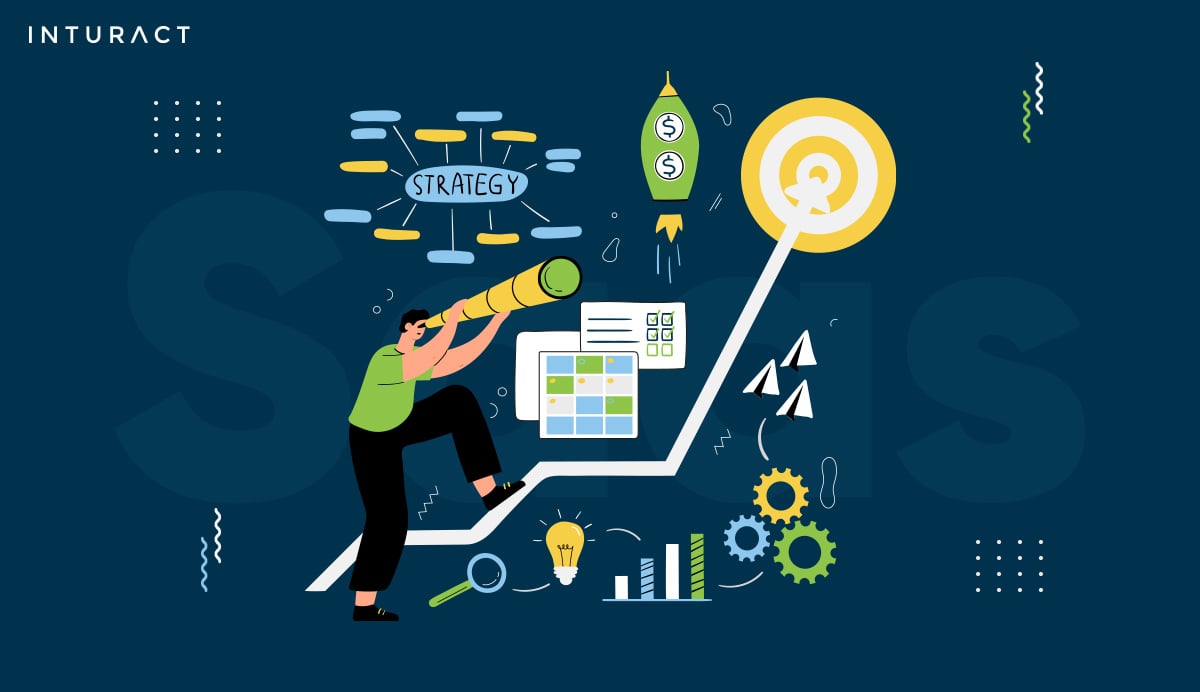4 SaaS Marketing Challenges And How to Overcome Each One

In the world of SaaS, marketing challenges are like shapeshifters — always present, but constantly evolving as your business grows.
When you’re just starting out, your biggest hurdle might be simply getting noticed. Fast forward a bit, and you’ve gained some traction. Suddenly, you’re facing a different beast: lead generation. And if you’re setting your sights on larger enterprises, get ready for marathon sales cycles that test your patience and resources.
In this article, we’re diving deep into five of the most persistent challenges SaaS marketers face. More importantly, we’ll equip you with practical, proven strategies to tackle each one head-on.
Standing out in a crowded and competitive market
The sheer number of similar offerings in the market for any kind of SaaS product is overwhelming, making it difficult for any single product to capture attention. This problem is compounded by the fact that as products mature, competitors often end up with similar feature sets, eroding the ability to differentiate based on functionality alone.
Without a clear differentiator, businesses may find themselves in a constant struggle to retain customers who see little reason to stay loyal when similar, possibly cheaper, alternatives are just a click away. To overcome these hurdles, companies need to think beyond product features and dig deeper into what truly makes them unique.
How to overcome this challenge: Find your USP
A Unique Selling Proposition (USP) is the core factor that sets a product or service apart from its competitors. It’s the key reason why customers should choose your offering over others.
For example, by positioning itself as the solution for “design for everyone,” Canva was able to attract a large user base that professional design tools weren’t serving well. Their USP allowed them to compete not by trying to outdo Adobe on professional features, but by reimagining what design software could be for a different audience.
Source: Canva
They identified a gap in the market: many people and small businesses needed to create visual content but found existing tools too complex and time-consuming. To develop this USP, Canva likely conducted extensive user research to understand the frustrations people faced with existing design tools. They also studied the growing need for visual content across social media and digital marketing, identifying a trend that traditional design software wasn’t fully addressing.
A good USP typically has these characteristics:
To find your USP, start by deeply understanding your target audience. What are their pain points? What do they value most? Next, analyze your competitors. What are they offering? Where are the gaps in the market? Look at your own strengths and what makes your offering different. This could be a unique feature, a novel approach, superior quality, exceptional service, or even a distinctive brand personality.
A USP isn’t just a tagline – it should guide your product development, marketing strategy, and overall business approach. Use it in all aspects of your marketing and communications. It should be clear on your website, in your ass, and throughout your customer interactions. Your USP should inform your product roadmap, ensuring you continue to deliver on your unique promise.
Generating qualified leads consistently

It’s not a great strategy if you’re attracting a lot of leads, and then trying to find those who are genuinely interested in your product and likely to convert into paying, long-term users. It will waste your time and effort otherwise spent learning about your ideal customer or developing your product.
Another aspect of this challenge is the need for continuous optimization. What works to generate leads today might not work tomorrow, as market conditions, customer preferences, and algorithms change. This requires constant testing, learning, and adapting lead generation strategies.
Not addressing this challenge can cause the sales pipeline to dry. This can lead to cash flow issues, making it difficult to invest in product development or marketing initiatives.
How to overcome this challenge: Know your customers and where they hang out
Start by creating detailed buyer personas. Go beyond basic demographics and dig into their goals, challenges, preferences, and behaviors. Use surveys, interviews, and data analysis to build a comprehensive picture. Look at your current best customers – what traits do they share?
Once you know who your ideal customer is, research where they spend their time online and offline. Do they frequent specific forums, social media platforms, or industry events? Are there particular publications they read or influencers they follow? This knowledge allows you to focus your marketing efforts where they’re most likely to be seen and appreciated by your target audience.
By targeting the right people in the right places, you’ll likely see higher conversion rates and lower customer acquisition costs. Your message will resonate more strongly because it’s reaching people who actually need your solution.
An example of this approach is how Shopify leveraged YouTube to connect with its target audience. Shopify recognized that many aspiring entrepreneurs and small business owners, their ideal customers, frequently turned to YouTube for practical business advice and tutorials.
Responding to this insight, Shopify created a YouTube channel filled with valuable content.
Source: Shopify
Shopify didn’t just focus on how to use their platform, but covered a wide range of topics relevant to their audience’s interests and needs. This included videos on marketing strategies, inventory management, photography tips for product shots, and success stories from other entrepreneurs.
By providing this free, high-quality content, Shopify positioned itself as a helpful resource and thought leader in the e-commerce space. This strategy helped them attract qualified leads who were already interested in starting or growing an online business.
Reducing churn and improving customer retention
Churn is when customers stop using a service or product. They cancel their subscription or don’t renew it. For example, if you start a month with 100 customers and 5 leave, your monthly churn rate is 5%.
There are two main types of churn:
High churn is bad for business because:
In competitive markets, customers always have other options to consider. It’s also easy to switch between SaaS products. The challenge is made worse by changing customer needs and expectations. What keeps a customer happy today might not work tomorrow. All this makes churn inevitable. But not impossible to fix.
How to overcome this challenge: User onboarding, regular feedback, and great customer service
To reduce churn, you have to show customers the value of your product right from the start. You can do it via user onboarding — helping them understand how your software works and showing them how to get the most value from it as quickly as possible. Because, if users find your product confusing or don’t see its value quickly, they’re more likely to stop using it. But if onboarding helps them succeed early on, they’re more likely to become long-term, happy customers.
Good onboarding usually includes a mix of different elements. You might have a welcome email that explains the next steps. There’s often a guided tour of the main features when a user first logs in. Many products use tooltips to explain different parts of the interface. Some create short tutorial videos or a knowledge base with articles explaining how to use the product.
The goal of onboarding is to help users reach their “aha moment” – the point where they really see how your product can help them. For example, with Dropbox, this might be when a user first syncs a file across devices. For a social media app, it could be when they make their first connection.
Navigating long and complex sales cycles with multiple decision-makers
This challenge stems from the nature of big organizations, where buying decisions often involve numerous stakeholders, each with their own concerns and priorities.
These sales cycles can stretch for months or even years, tying up resources and making revenue forecasting difficult. The complexity arises because each decision-maker might need different information or have unique objections to overcome. For example, the IT department might focus on security and integration, while finance cares about ROI, and end-users are concerned with ease of use.
The challenge is further complicated by the need to maintain momentum throughout the lengthy process. Keeping all parties engaged and aligned over an extended period can be tricky, especially when priorities shift or key contacts change roles.
How to overcome this challenge: Create a champion within the target organization
To overcome the challenge of long, complex sales cycles with multiple decision-makers, focus on creating a champion within the target organization. This internal advocate can be a powerful ally in navigating the complex buying process.
First, identify a key stakeholder who stands to benefit significantly from your solution. This person should have influence within the organization and a vested interest in seeing your product implemented.
Then, invest time in building a strong relationship with this potential champion. Provide them with in-depth knowledge about your product, focusing on how it solves their specific pain points. Equip them with case studies, ROI calculations, and other materials they can use to make a compelling case for other decision-makers. Regularly check in with your champion, offering support and insights they can use to address concerns from other stakeholders. Help them anticipate and prepare for objections from different departments.
Empower your champion by involving them in the process. For example, you might co-create an implementation roadmap or customize a demo specifically for their organization. By nurturing a strong internal advocate, you create a valuable insider who can help push the deal forward, provide insights into the decision-making process, and champion your solution when you’re not in the room.
Get expert help to overcome all your marketing challenges
By now, you might be feeling both excited about the possibilities and perhaps a bit overwhelmed by the challenges ahead. That’s perfectly normal – SaaS marketing is a complex, ever-evolving field.
While the strategies we’ve discussed can certainly help you make strides in your marketing efforts, implementing them effectively often requires deep expertise and dedicated resources. This is where many SaaS companies find themselves at a crossroads: do you build out an in-house team to tackle these challenges, or do you seek expert guidance to accelerate your growth?
If you’re leaning towards the latter, you might want to consider partnering with a specialized B2B SaaS growth agency. That’s where Inturact can help. Inturact is a data-driven growth partner for SaaS companies that are committed to helping products overcome stagnation and achieve sustainable growth.
Unlike many other growth consultants, Inturact offers solutions only after thoroughly examining your data. This approach ensures that the strategies are based on solid evidence rather than guesswork. We bring together 15+ years of industry expertise with data science and machine learning to diagnose exactly why your product isn’t growing and then provide the exact playbook you need to get unstuck.
Whether you need help with marketing, onboarding, churn reduction, or pricing analysis, we can provide the insights and execution support you need to grow at a rate you’ve not seen before.
Schedule a call with Inturact today and let us show you your growth potential.



